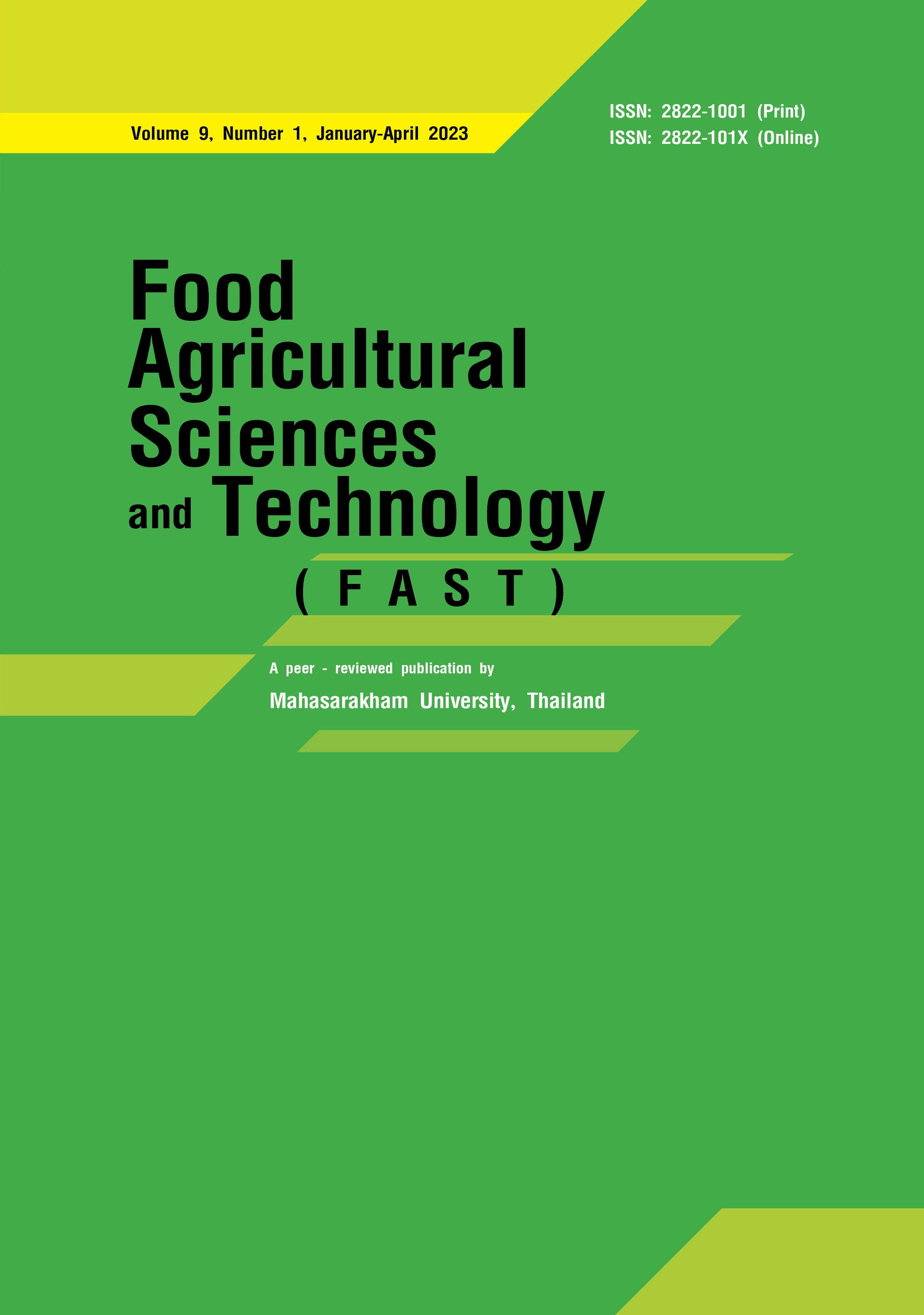Antioxidant activity and sensory evaluation of mixed vegetables (Piper sarmentosum Roxb. and Brassica rapa subsp. pekinensis) crispy snack
Keywords:
Antioxidant activity, ready-to-eat snacks, crispy vegetable, sensory evaluation, chemical propertiesAbstract
This research aimed to examine the antioxidant activity, chemical, physical properties and sensory evaluation of mixed vegetables (Cha-Plu, Piper sarmentosum Roxb. and Chinese cabbage, Brassica rapa subsp. pekinensis) crispy snack (MVCS). Three treatments of MVCS with varying ratio of vegetables (P. sarmentosum : Brassica rapa subsp. pekinensis ) comprising MVCS (2:1), MVCS (1:1), and MVCS (1:2) were examined. The increasing of P. sarmentosum showed a significant on ash (20.21±0.19a ) and crude fiber (13.85±0.13a ). However, other proximate composition such as crude lipid, crude protein and carbohydrate were not a significant difference (P ≥0.05). Meanwhile, MVCS (1:2) that with high ratio of Chinese cabbage had the highest lightness (65.03±0.98a ). Regarding texture profile analysis, MVCS (1:2) showed the highest force on hardness (N) (172.40±3.03a ) but the minimum crispness (N) of 6.73±3.03c was noted for MVCS (2:1). Besides, the highest total phenolic content (650.20 mg/100 g DW) and DPPH radical-scavenging activity (898 mg Trolox equivalent mg/100 g DW) were observed in MVCS (2:1). Regarding sensory evaluation, the majority of panelists scored 7.63±1.16a out of 9 for MVCS (1:1) on the overall acceptability and other dimensions also received the highest score among three samples. Therefore, the nutrition value and sensory evaluation results from this study indicated that mixed Cha-Plu and Chinese cabbage could produce a snack with significant higher antioxidant activity and a variety of healthy snacks in order to capture the opportunity in a healthy food market.
References
AOAC. (2005). Official methods ofsanalysis (18th ed.). Association of Official Analytical Chemists, USA.
Burgos, G., Amoros, W., Munoa, L., Sosa, P., Cayhualla, E., Sanchez, C.,et al. (2013). Total phenolic, total anthocyanin and phenolic acid concentrations and antioxidant activity of purple-fleshed potatoes as affected by boiling. Journal of Food Composition and Analysis, 30, 6-12.
Calubaquib, B. J., & Suyu, C. M. (2020). Proximate composition of fortified Filipino snacks for picky eaters. Indian Journal of Science and Technology, 13(1), 61-69.
Chanprapai, P., & Chavasiri, W. (2017). Antimicrobial activity from Piper sarmentosum Roxb. against rice pathogenic bacteria and fungi. Journal of Integrative Agriculture, 16(11), 2513-2524.
Chen, J., Venkitasamy, C., Shen, Q., McHugh, H. T., Zhang, R., & Pan, Z. (2018). Development of healthy crispy carrot snacks using sequential infrared blanching and hot air-drying method. LWT - Food Science and Technology, 97, 469-475.
Chun, J., Kang, Y., Lee, J., Yun, Y., Oh, T., & Yoon, M. (2022). The combined effect of nitrogen and biochar amendments on the yield and glucosinolate contents of the Chinese cabbage. Journal of King Saud Universit- Science, 34, 101799. https://doi.org/10.1016/ j.jksus. 2021.101799.
Fang, H., Yin, X., He, J., Xin, S., Zhang, H., Ye, X., Yang, Y., & Tian, J. (2022). Cooking methods affected the phytochemicals and antioxidant activities of potato from different varieties. Food Chemistry: X, 14,100339. https://doi.org/10.1016/j.fochx.2022.100339.
Folorunso, A. A., Omoniyi, S. A., & Habeeb, A. S. (2016). Proximate composition and sensory acceptability of snacks produced from broken rice (Oryza sativa) flour. American Journal of Food and Nutrition, 6(2), 39-43.
Forsberg, S., Olsson, V., Bredie, P. L. W., & Wendin, K. (2022). Vegetable finger foods-Preferences among older adults with motoric eating difficulties. International Journal of Gastronomy and Food Science, 28, 100528. https://doi.org/10.1016/ j.ijgfs. 2022.100528.
Grzegorzewska, M., Badełek, E., Szczech, M., Kosson, R., Wrzodak, A., Kowalska, B., Colelli, G., SzwejdaGrzybowska, J., & Maciorowski, R. (2022). The effect of hot water treatment on the storage ability improvement of fresh-cut Chinese cabbage. Scientia Horticulturae, 291,m110551.https://doi.org/10.1016/j. scienta. 2021.110551.
González-Jiménez, F. E. Cooper-Bribiesca, B. L., Hernandez-Espiosa, N., NunezBreton, L. C., & Reyes-Reyes, M. (2015), Empleo de antioxidants en el tratamiento de diversas enfermedades cronico-degenerativas. Vertientes Rev. Espec. En Ciencias la Salud, 18, 16-21.
Hafizah, A., Zaiton, Z., Zulkhairi, A., Mohd, I. A., Anita, N. M., & Zaleha, A. (2010). Piper sarmentosumas an antioxidant on oxidative stress in human umbilical vein endothelial cells induced by hydrogen peroxide. Journal of Zhejiang University Science (B), 11, 357-365.
Jung, J. S., Kim, J. M., and Chae, W. S. (2016). Quality and functional characteristics of kimchi madewith organically cultivated young Chinese cabbage (olgari-baechu). Journal of Ethnic Foods, 3, 150-158.
Kim, J., John, M. M. K., Hae-Kyung, M., Jin, K., Enkhtaivan, G., & Kim, H. D. (2014). Morphological and biochemical variation of Chinese cabbage (Brassica rapa spp. Pekinensis) cultivated using different agricultural practices. Journal of Food Composition and Analysis, 36, 12-23.
Konopacka, D., Seroczynska, A., Korzeniewska, A., Jesionkowska, K., NiemirowiczSzcztt, K., & Plocharski, W. (2010). Studied on the usefulness of Cucurbita maxima for the production of ready-to-eat dried vegetable snacks with a high carotenoid content. LWT-Food Science and Technology, 43, 302-309.
Lisiecka, K., Wojtowicz, A., Mitrus, M., Oniszczuk, T., & Combrzynski, M. (2021). New type of potato-based snack-pellets supplemented with fresh vegetables from the Allium genus and its selected properties. LWT, Food Science and Technology, 145, 111233. https://doi.org/10.1016/j.lwt. 2021.111233.
López-Hernández, A. A., Ortega-Villarreal, S. A., Rodriguea, V. A., Lomeli, L. M., & González-Martínez, E. B. (2022). Application of different cooking methods to improve nutritional quality of broccoli (Brassica oleracea var. italica) regarding its compounds content with antioxidant activity. International Journal of Gastronomy and Food Science, 28, 100510. https://doi. org/10.1016/j.ijgfs. 2022.100510.
Masuda, T., Inazumi, A., Yamada, Y., Padolina, W.G., Kikuzaki, H. & Nakatani, N. (1991). Antimicrobial phenylpropanoids from Piper sarmentosum. Phytochemistry, 30, 3227-3228.
Nicklett, E.J. & Kadell, A.R. (2013). Fruit and vegetable intake among older adults: a scoping review. Maturitas, 75 (4), 305-312. https://doi.org/ 10.1016/j.maturitas. 2013.05.0005.
Nielsen ILC. (2022, June 13). Global snack food sales reach $374 billion annually.wGrand view researcht.
Raman, V., Galal, A. M., & Khan, I. A. (2012). An investigation of the vegetative anatomy of Piper sarmentosum, and a comparison with the anatomy of Piper betle (Piperaceae). American Journal of Plant Sciences, 3, 1135-1144.
Romanet, R., Sarhane, Z., Bahut, F., Uhl, J., Schmittkopplin, P., Nikolantonaki, M., et al. (2021). Exploring the chemical space of white wine antioxidant capacity: A combined DPPH, EPR and FT-ICR-MS study. Food Chemistry, 355, 129566.
Santosh, O., Bajwa, K. H., Bisht, S. M., & Chongtham, N. (2021). Antioxidant activity and sensory evaluation of crispy salted snacks fortified with bamboo shoot rich in bioactive compounds. Applied Food Research, 1, 100018.
Shah, F. U. H., Sharif, M. K., Butt, M. S., & Shahid, M. (2017). Development of protein, dietary fiber, and micronutrient enriched extruded corn snacks. Journal of Texture Studies, 48, 221-230. https://doi. org/10.1111/jtxs.1223.
Stokkom, V. L. V., Graaf, D. C., Wang, S. Kooten, V. O., & Stieger, M. (2019). Combinations of vegetables can be more accepted than individual vegetables. Food Quality and Preference, 72, 147-158.
Sun, X., Chen, W., Dai, W., Xin, H., Rahmand, K., Wang, Y., Zhang, J., Zhang, S., Xu, L., & Han, T. (2020). Piper sarmentosum Roxb.: A review on its botany, traditional uses, phytochemistry, and pharmacological activities. Journal of Ethnopharmacology, 265(5), 112897. https://doi.org/10.1016 /j.jep.2020.112897.
Torres, S., Contreras, L., Veron, H., & Isla, I., M. (2022). Chapter 10 - Prospects of dairy and vegetables-based food products in human health: Current status and future directions. Research and Technological Advances in Food Science, 243-267.
World Health Organizatio). (2020). Increasing fruit and vegetable consumption to reduce the risk of noncommunicable diseases. World Health Organization.
Yang, B., Ma, W., Wang, S., Shi, L., Li, X., Ma, Z., Zhang, Q., & Li, H. (2022). Determination of eight neonicotinoid insecticides in Chinese cabbage using a modified QuEChERS method combined with ultra performance liquid chromatography-tandem mass spectrometry. Food Chemistry, 387, 132935. https://doi.org/10.1016/j. foodchem.2022.132935
Downloads
Published
How to Cite
Issue
Section
License
Copyright (c) 2023 Food Agricultural Sciences and Technology (FAST)

This work is licensed under a Creative Commons Attribution-NoDerivatives 4.0 International License.







